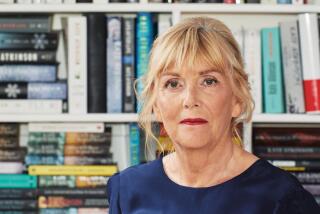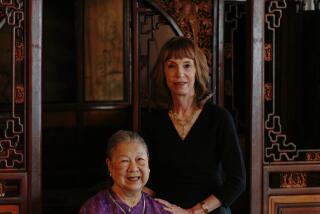BOOK REVIEW / NOVEL : From the Mouth of a Babe, the Details of Ordinary Lives : BEHIND THE SCENES AT THE MUSEUM by Kate Atkinson; St. Martin’s Press $22.95, 336 pages
- Share via
Ruby Lennox, the heroine of Kate Atkinson’s stunning first novel, out-Copperfields “David Copperfield.” While Dickens’ David began narrating at his birth, Atkinson’s narrator begins working at the moment of her conception.
And hers is indeed a quest to see if she will be the hero of her own story. For the first 40 pages of “Behind the Scenes at the Museum,” we are being guided by an embryo with an all-seeing, wise-guy take on the world. She’s living in York, England, a place so rife with history “there’s no room for the living.”
She knows the future, she knows the past. Her mostly tragic narrative about a completely ordinary, working-class family will hop, skip, and swirl backward and forward through time. Every member of the various generations introduced will fall into his or her place in a huge, albeit confusing family tree. (Is Clifford Bunty’s uncle or brother? Whose son is Adrian? Whatever happened to Auntie Eliza? Auntie Eliza--”about as common as you can get. We know this has something to do with the fact that her blond hair has coal-black roots and she is wearing immense rhinestone earrings.”)
Ruby, our narrator, is the third child of George and Bunty, who met in 1944. When the novel opens in the early ‘50s, lean, gray years in postwar Britain, they live in a dark, dank, cramped, ancient building above the family pet shop. Ruby alone sees the ghosts of all of the occupants from over the centuries. They don’t bother anybody, and tend to congregate on the many winding narrow staircases.
To the little girl, the spirits inhabit the place; somehow they seem more comforting than her family. Her oldest sister, Patricia, is a dour 5-year-old; imperious Gillian is already a terror at 3; father George sells budgies, puppies and kittens with no more feeling for his merchandise than the medical supplies he will sell later, after the disastrous pet-shop fire. He plays around with the ladies too, on nights out with his old mate Walter, the meat man. So he’s not around the night that Bunty gives birth to his third daughter, Ruby.
Remember, we’re hearing all this from an embryo, now a newborn: “The midwife goes away, the neat, tip-tapping of her black lace-up shoes on the linoleum of the corridor gradually fades and we are left alone. We lie in our cots, wrapped tightly in white cotton-cellular blankets, like promises.”
Promise is the key word here. Atkinson’s first novel is a powerhouse of storytelling, a treasure chest bursting with the painful, pitiful, sad, always fascinating details of the most ordinary of lives--farmers, shopkeepers, stepdaughters, salesmen, simple soldiers. She’s telling tales that sweep from the 1890s through the 1980s. Stories that range from the moors of Yorkshire to the trenches of World War I to the remote west of Canada in the ‘50s and ‘60s. At the same time we never escape the center of Ruby’s world, in the crowded heart of York, with its winding, crooked streets and buildings that lean into each other like gossiping women.
We never escape Bunty, the mother from hell. “My real mother is roaming in a parallel universe somewhere, ladling out mother’s milk the colour of Devon cream,” Ruby writes. “I don’t like porridge,” 5-year-old Patricia says to her mum at breakfast one day. “As fast as a snake, Bunty hisses back, ‘Well, I don’t like children, so that’s too bad for you, isn’t it?’ ” (She doesn’t like animals much either. Even though they own a pet shop, the Lennox children are never allowed a pet.)
Ruby’s sisters vanish one by one--by death, by intention. Ruby is already a typically pained adolescent in the early ‘60s, burdened with a tragic family history, when she loses her father. Left alone with Bunty, her teenage angst is aggravated by panic attacks, low self-esteem, her mother’s emotionally abusive boyfriend and a hunger for a mother’s love.
Atkinson’s revelation of what lies at the heart of the bitter relationship between Bunty and her youngest daughter proves only one of several riveting surprises that conclude this novel.
My only quibble with Atkinson’s otherwise marvelous story is what we don’t learn about Ruby’s own emotional and sexual maturity. We never hear her thoughts on boys (or girls, for that matter). We know more than we’d like to about the sex lives of her relatives and family. Ruby’s hasty marriage takes place off-stage and leaves one hungry for more detail about her mysterious adult life.
This past summer when I visited York with my husband and daughter, I went to the Castle museum, where previous eras are brought to life through tableaux. I remember a re-creation of a working-class family’s sitting room prettied up with a new telly and festive tea things for the coronation of Queen Elizabeth. What a sad, cramped little room, I thought. After reading “Behind the Scenes at the Museum,” it will always be the Lennox family I see in that claustrophobic room, gathered around that ancient television set, little Ruby parading in one of the homemade, crepe-paper flower coronets all-too-common Auntie Eliza made for the little girls.
More to Read
Sign up for our Book Club newsletter
Get the latest news, events and more from the Los Angeles Times Book Club, and help us get L.A. reading and talking.
You may occasionally receive promotional content from the Los Angeles Times.






